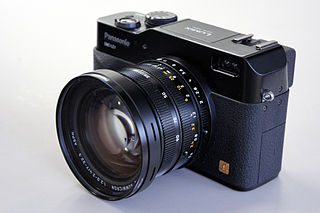
The Four Thirds System is a standard created by Olympus and Eastman Kodak for digital single-lens reflex camera (DSLR) and mirrorless camera design and development.

A digital single-lens reflex camera is a digital camera that combines the optics and the mechanisms of a single-lens reflex camera with a solid-state image sensor and digitally records the images from the sensor.

Sigma Corporation is a Japanese company, manufacturing cameras, lenses, flashes and other photographic accessories. All Sigma products are produced in the company's own Aizu factory in Bandai, Fukushima, Japan. Although Sigma produces several camera models, the company is best known for producing high-quality lenses and other accessories that are compatible with the cameras produced by other companies.

Lumix is Panasonic's brand of digital cameras, ranging from pocket point-and-shoot models to digital SLRs.

In digital photography, the image sensor format is the shape and size of the image sensor.

The Micro Four Thirds system is a standard released by Olympus and Panasonic in 2008, for the design and development of mirrorless interchangeable lens digital cameras, camcorders and lenses. Camera bodies are available from Blackmagic, DJI, JVC, Kodak, Olympus, Panasonic, Sharp, and Xiaomi. MFT lenses are produced by Cosina Voigtländer, DJI, Kowa, Kodak, Mitakon, Olympus, Panasonic, Samyang, Sharp, Sigma, SLR Magic, Tamron, Tokina, TTArtisan, Veydra, Xiaomi, Laowa, Yongnuo, Zonlai, Lensbaby, Kowa, Venus Optics and 7artisans amongst others.

The Panasonic Lumix DMC-G1 was the first digital mirrorless interchangeable-lens camera (MILC) adhering to the Micro Four Thirds system design standard. The G1 camera is similar to the larger Four Thirds system format DSLR cameras, but replaces the complex optical path needed for the optical viewfinder with an electronic viewfinder EVF displaying a live view image directly from the sensor. Eliminating the mirror box and optical viewfinder allows for smaller and lighter camera bodies, while the less complex optical path also allows for smaller, lighter lens designs.
The Samsung NX-mount is the lens mount used on NX series mirrorless interchangeable lens cameras by Samsung. The mount was first implemented in the Samsung NX10, and Samsung initially referred to the NX line as 'hybrid digital cameras', citing their combination of attributes of both DSLR and compact cameras.

A mirrorless camera is a photo camera featuring a single, removable lens and a digital display. The camera does not have a reflex mirror or optical viewfinder like a digital single-lens reflex (DSLR) camera, but may have an electronic viewfinder. Many mirrorless cameras retain a mechanical shutter. Like a DSLR, a mirrorless camera accepts any of a series of interchangeable lenses compatible with its lens mount.

The E-mount is a lens mount designed by Sony for their NEX and ILCE series of camcorders and mirrorless cameras. The E-mount supplements Sony's α mount, allowing the company to develop more compact imaging devices while maintaining compatibility with 35mm sensors. E-mount achieves this by:
The Pentax Q series is a series of mirrorless interchangeable-lens cameras made by Pentax and introduced in 2011 with the initial model Pentax Q. As of September 2012, it was the world's smallest, lightest interchangeable lens digital camera. The first models used a 1/2.3" back-illuminated sensor CMOS image sensor. The Q7, introduced in June 2013, uses a larger 1/1.7" type sensor. The Q system is now discontinued.
The Samsung NX series was a series of APS-C mirrorless interchangeable-lens cameras with Samsung NX lens mounts from Samsung Electronics, introduced in 2010.

The Leica SL is a full-frame mirrorless interchangeable-lens camera announced by Leica Camera AG on 20 October 2015. The SL is promoted as a camera system for professional applications. Beside the Leica S-System, the Leica SL-System is the 2nd professional camera system in the company's product portfolio.

The Panasonic Lumix DC-GH5 is a Micro Four Thirds mirrorless interchangeable lens camera body announced by Panasonic on 4 January 2017.

The Leica L-Mount is a bayonet mount developed by Leica Camera AG for interchangeable-lens autofocus digital cameras.

Nikon Z-mount is an interchangeable lens mount developed by Nikon for its mirrorless digital cameras. In late 2018, Nikon released two cameras that use this mount, the full-frame Nikon Z 7 and Nikon Z 6. In late 2019 Nikon announced their first Z-mount camera with an APS-C sensor, the Nikon Z 50. In July 2020 the entry level full-frame Z 5 was introduced. In October 2020, Nikon announced the Nikon Z 6II and Nikon Z 7II, which succeed the Z 6 and Z 7, respectively. The APS-C lineup was expanded in July 2021, with the introduction of the retro styled Nikon Z fc, and in October 2021, Nikon unveiled the Nikon Z 9, which effectively succeeds the brand's flagship D6 DSLR. The APS-C lineup was further expanded with the Nikon Z 30, announced at the end of June 2022.
The Leica SL2 is a full-frame mirrorless interchangeable-lens camera released by Leica Camera on 6 November 2019. The camera uses the Leica L-Mount lenses range and is part of the L-Mount Alliance of camera bodies that Leica co-developed with Panasonic and Sigma.
The Leica S-System is a medium format digital single lens reflex camera system introduced by Leica Camera in 1996. Beginning with the Leica S1, a prototype top-end studio digital camera unveiled at Photokina 1996. It went into production at the end of 1997.














